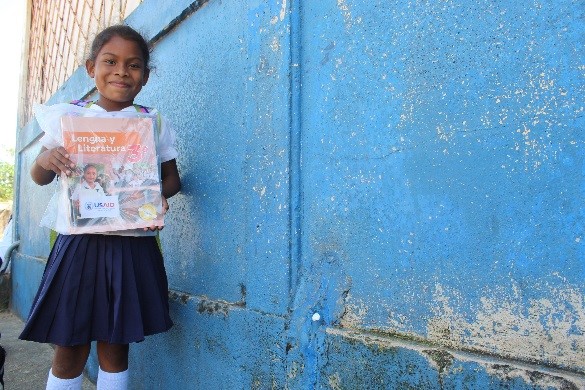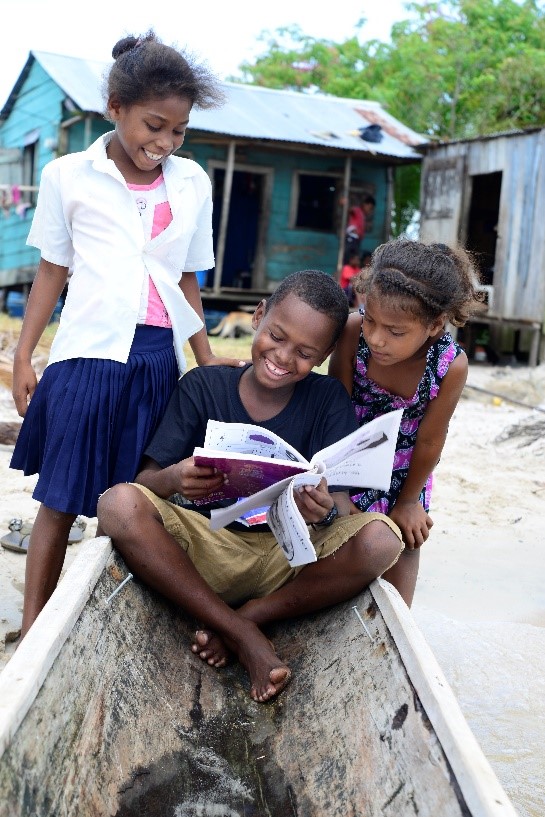

DevTech Advances a Culture of Evaluating Early Childhood Reading in Multilingual Contexts in Nicaraguan Schools
By Solange Casanova, Miguel Nunez, and Ileana Lacayo (DevTech CARS Project Team) | August 9, 2018
The capacity to read and comprehend a simple text is one of the most fundamental abilities a child can learn. Without this critical ability, there are few possibilities for students to escape the “cycle of intergenerational poverty.” In other words, they lack the foundation to achieve key learning goals early on to develop the necessary capacities for labor market insertion or to produce and generate sufficient income to pull themselves out of poverty.
In many countries, students in primary school are incapable of reading or comprehending a simple text. Recent evidence indicates that in order to learn to read well, it is essential to both start learning early and at a sufficient pace for comprehension. Literacy is more and more difficult to achieve as learners grow.
 |
This fact leads us to the need to create simple and efficient methods for learning to read at a low cost. In response to this demand, the Early Grade Reading Assessment (EGRA) instrument was created. The reason for developing the EGRA was to help countries working with USAID to initiate a process for systematically measuring how well boys and girls in primary grades were able to acquire reading abilities and ultimately to encourage more effective efforts for improving reading and learning outcomes. EGRA has been applied in more than 50 countries, with EGRA work in Nicaragua being the first of its kind in Latin America. Since 2013, DevTech Systems, Inc. has implemented the USAID-funded project, Community Action for Reading and Security (CARS) in eight municipalities on the Nicaraguan Caribbean Coast, where the greatest challenges in education and security exist in comparison to the national average.
DevTech carried out a baseline survey in 2014 in the Southern Caribbean Coast (RACCS) and a mid-term evaluation in the same region in 2016 to measure the achievements of the CARS Project in improving reading comprehension. In 2018, CARS administered a second baseline survey in the Northern Caribbean Coast (RACCN) of Nicaragua focusing on reading comprehension in multilingual contexts.
The study in 2018 was applied to 2,104 students, 1,202 in the RACCN and 902 in the RACCS. In the RACCS, the test was developed in Spanish because that was the language of instruction; 77% of the students speak Spanish as their mother language, 17% speak Creole, and 5% speak Miskitu. In the RACCN, only 28% of the students speak Spanish as their mother language, 71% speak Miskitu, and less than 1% speak Creole. Thus, in the RACCN, 34% of the tests were applied in Spanish and 66% in Miskitu, according to the language of instruction reported by each school. Some students were evaluated both in Miskitu and in Spanish to determine if there were significant differences in the results.
Students were given two readings in their language of instruction, obtaining results shown in the table below.
In the case of Spanish, students obtained better results with the second reading, reaching a fluency level of approximately 18, 45, and 65 correct words per minute for first, second, and third grades, respectively. This fluency is, on average, 21% better than the fluency of the first reading. In the case of Miskitu, the results showed a reading fluency of 3, 8, and 24 correct words per minute for first, second, and third grades, respectively. The second reading was only 7% better than the fluency of the first reading. The evaluated students in Spanish had a reading fluency six times better for first and second grade and nearly three times better for third grade, than the students evaluated in Miskitu.
The results of Graph 1 show that at a regional level, the RACCN accounts for much lower levels of reading, for both Spanish and Miskitu, in comparison to the results of the RACCS. The differences are especially high in second grade where the evaluated students in Spanish in the RACCN measured 31% lower in reading than those in the RACCS. In first grade, the difference was 25% and in third grade, the difference was 8%, both in favor of the RACCS. Upon further analysis, we found that 95% of the students evaluated in Miskitu in the RACCN, spoke Miskitu as their mother language in their homes, while only 67% of the students evaluated in Spanish in the RACCN spoke Spanish in their homes (the rest, 31%, spoke Miskitu).
The results for the RACCS are consistent with the mid-term evaluation conducted in 2016. DevTech expected that the results for the RACCN would be less than those from the RACCS, but not in the range of 47% lower (for Spanish). Nevertheless, this is an opportunity for CARS to generate a greater impact with the students: the lower the results, the greater the margin for improvement as a result of the implementation. At the end of 2018, we will carry out a final evaluation of these schools to determine the results of the project in improving the reading outcomes of beneficiary students.
With the application of EGRA in the RACCN, DevTech was able to successfully adapt the EGRA instrument to the local RACCN context and analyze the results to identify measures and standards for determining fluency and comprehension in the Miskitu language, promoting inclusion in the region and informing future education policy making.
Photos and Captions
Photo 1 caption: Young primary school girl from Waspam indigenous community receiving donated reading materials and textbooks from USAID through the CARS Project.
Photo 2 caption: Children from the Tasbapauni indigenous community in the RACCN reading together during an after school program administered by CARS.